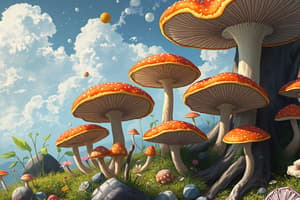Podcast
Questions and Answers
What is the name of the main portion of the mushroom which grows underground?
What is the name of the main portion of the mushroom which grows underground?
Mycelium
Which of the following is NOT a characteristic of fungi?
Which of the following is NOT a characteristic of fungi?
- They are eukaryotic cells.
- They are prokaryotic cells. (correct)
- They decompose organic matter.
- They reproduce asexually.
Which protists are the base of the marine food chain?
Which protists are the base of the marine food chain?
Phytoplankton
Which of the following characteristics differentiate fungi from plants?
Which of the following characteristics differentiate fungi from plants?
Which of the following is an example of fungi playing an important role in maintaining ecosystem balance and health?
Which of the following is an example of fungi playing an important role in maintaining ecosystem balance and health?
Which of the following is NOT a characteristic of a protist?
Which of the following is NOT a characteristic of a protist?
Which of the following is NOT one of the three general types that protists can be organized into?
Which of the following is NOT one of the three general types that protists can be organized into?
Kingdom Fungi is what type of cell?
Kingdom Fungi is what type of cell?
The cell wall of bacterial cells is made of ________.
The cell wall of bacterial cells is made of ________.
What is the process where a virus infects a cell by injecting its DNA called?
What is the process where a virus infects a cell by injecting its DNA called?
How are vaccines used to prevent viral infections?
How are vaccines used to prevent viral infections?
Which of the following is NOT a method of controlling bacterial growth?
Which of the following is NOT a method of controlling bacterial growth?
Which of the following characteristics is found only in organisms classified in the Kingdom Fungi?
Which of the following characteristics is found only in organisms classified in the Kingdom Fungi?
What are the three domains?
What are the three domains?
Which of the following is NOT a way to prevent viruses?
Which of the following is NOT a way to prevent viruses?
What term is used to identify a system of naming and classifying organisms based on shared characteristics and universal rules?
What term is used to identify a system of naming and classifying organisms based on shared characteristics and universal rules?
Which kingdoms have photosynthetic organisms?
Which kingdoms have photosynthetic organisms?
Which characteristic separates archaebacteria from bacteria?
Which characteristic separates archaebacteria from bacteria?
Flashcards are hidden until you start studying
Study Notes
Kingdom Fungi
- Mycelium is the main portion of the mushroom, primarily growing underground.
- Fungi are eukaryotic cells, classified as heterotrophic, distinguishing them from plants.
- Fungi contribute to ecosystem balance by breaking down organic matter and recycling nutrients.
Protists
- Phytoplankton are crucial as the base of the marine food chain.
- Protists are eukaryotic; they can reproduce via asexual or sexual methods.
- Characteristics of protists include diverse locomotion and methods of feeding like endocytosis and filter-feeding.
Virus Infections
- Lytic infections involve the virus destroying the host cell's DNA and taking over cellular functions.
- Lysogenic infections allow the viral DNA to merge with the host's DNA without destroying the host cell.
- Viruses have a capsid (protein coat) for protection of their genetic material, and some possess an additional viral envelope.
Classification System
- The three domains of life: Bacteria, Archaea, Eukarya.
- Taxonomy is the classification system for organisms based on shared characteristics.
- Six kingdoms include Eubacteria, Archaebacteria, Protista, Fungi, Plantae, and Animalia.
Bacterial Characteristics
- Bacteria are prokaryotic, lacking a nucleus and cell structures like ribosomes.
- Classification of bacteria relies on Gram staining; Gram-positive bacteria stain purple due to peptidoglycan-rich cell walls.
Vaccination and Disease
- Vaccines stimulate an immune response to prevent viral infections.
- Antibiotics are used for treating bacterial infections, but they are ineffective against viruses.
Unique Characteristics
- Kingdom Fungi contains organisms like yeast, mold, and mushrooms, characterized by multicellular filaments.
- Viruses, being intracellular parasites, do not have ribosomes or ATP and vary in structure with proteins and sometimes envelopes.
Organism Identification
- Dichotomous keys are tools used to identify organisms, utilizing pairs of descriptive statements.
- Characteristics like the structure of wings or mouthparts help classify insects and arachnids through dichotomous identification.
Notable Diseases
- Common symptoms of viral infections include fatigue, body aches, and jaundice for hepatitis B; sneezing and sore throat for the common cold; headaches and fever for influenza.
Cellular Structures
- Bubbles and projections in cells include cilia (small hair-like), pseudopods (temporary extensions), and flagella (whip-like tails), aiding in movement and feeding.
Studying That Suits You
Use AI to generate personalized quizzes and flashcards to suit your learning preferences.




